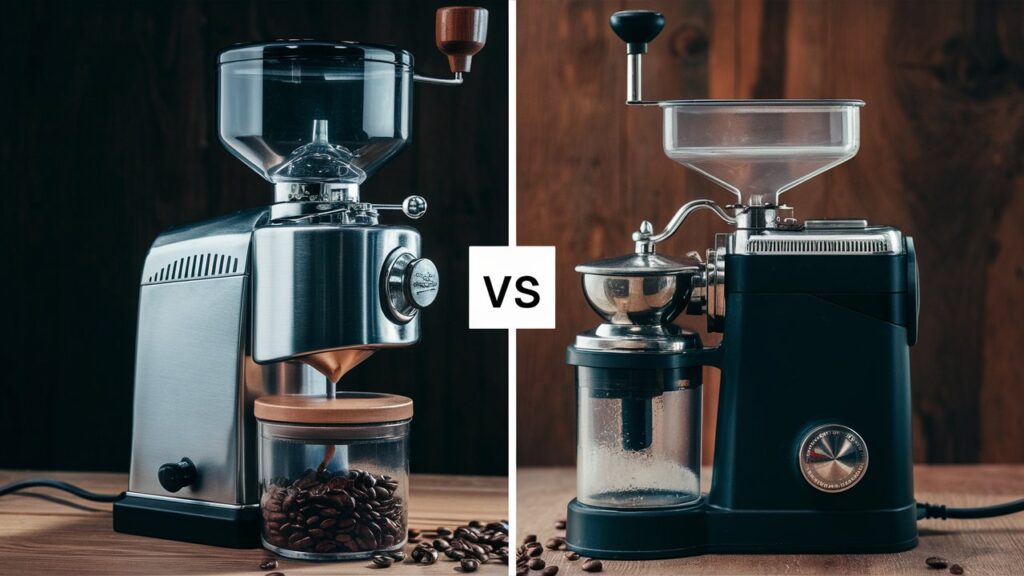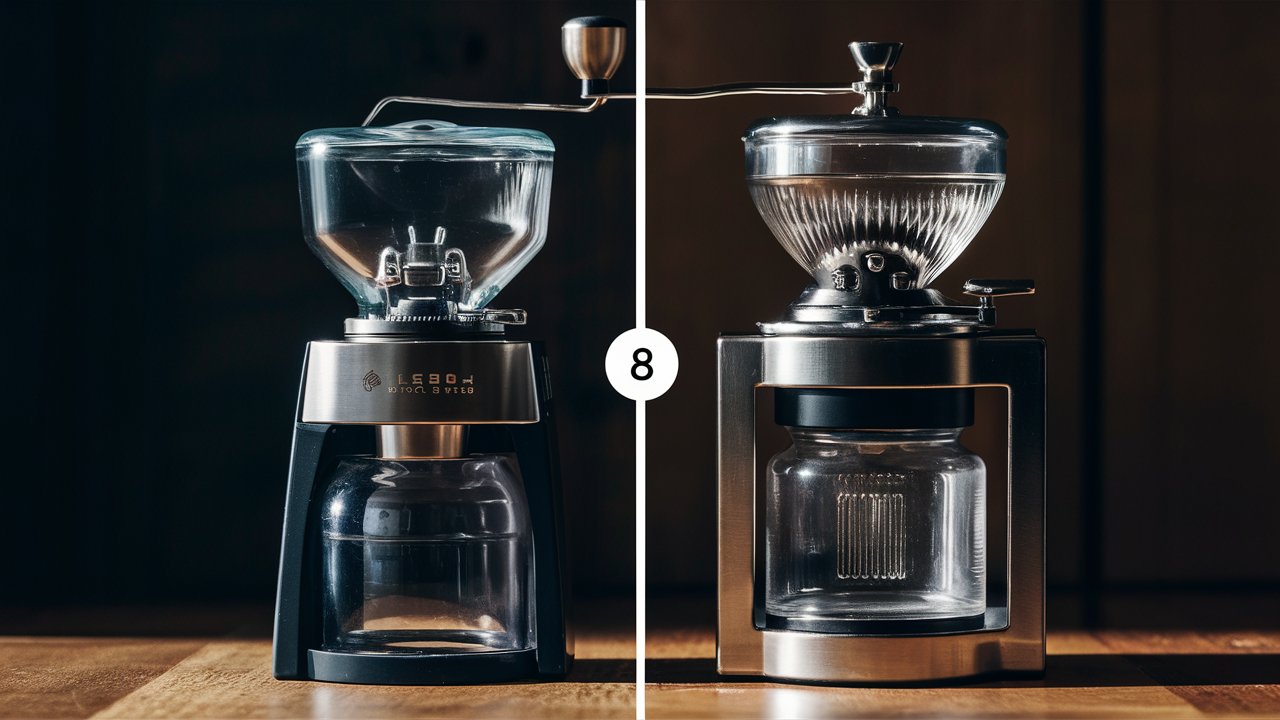
Coffee lovers know that grind quality is crucial. Choosing between burr and blade coffee grinders can change your coffee’s taste and texture. Let’s dive into the specifics of each type, helping you make an informed choice.
Understanding Blade Coffee Grinders
How Blade Grinders Work
Blade grinders chop coffee beans with a spinning blade. Simple mechanism: a blade at the grinder bowl’s bottom spins quickly, slicing through beans.
Advantages of Blade Grinders
- Affordability: Typically more affordable, perfect for beginners.
- Simplicity: Easy to use and clean due to straightforward design.
- Speed: Quick grinding, delivering ground coffee in seconds.
Disadvantages of Blade Grinders
- Inconsistency: Uneven grind sizes lead to inconsistent extraction.
- Heat Generation: Fast-spinning blades generate heat, affecting flavor.
- Limited Control: Less control over grind size, crucial for various brewing methods.
Exploring Burr Coffee Grinders
How Burr Grinders Work
Burr grinders use two abrasive surfaces, or burrs, to grind coffee beans. Adjusting the distance between burrs changes the grind size.
Types of Burr Grinders
- Flat Burr Grinders: Two flat burrs facing each other, producing consistent grind sizes, favored by professionals.
- Conical Burr Grinders: A cone-shaped burr inside a hollowed-out burr, quieter and less messy.
Advantages of Burr Grinders
- Consistency: Produces uniform grind sizes, essential for optimal extraction.
- Versatility: Adjustable settings for various grind sizes suitable for different brewing methods.
- Durability: Built to last, offering robust and reliable grinding.
Disadvantages of Burr Grinders
- Cost: More expensive than blade grinders.
- Complexity: More complex to operate and clean.
- Speed: Takes longer to grind beans compared to blade grinders.
Comparison: Burr vs. Blade Coffee Grinders
Grind Consistency and Quality
Burr grinders win on grind consistency. Uniform grind size ensures even extraction and a balanced flavor profile. Blade grinders result in coarse and fine particle mix, causing uneven extraction and bitter or sour coffee.
Control Over Grind Size
Burr grinders offer precise control over grind size, essential for different brewing methods like espresso, pour-over, French press, or drip coffee. Blade grinders lack this control, making them less versatile.
Heat and Flavor Preservation
Heat generation matters. High-speed blades in blade grinders create friction and heat, altering coffee flavor. Burr grinders operate slower, minimizing heat build-up and preserving natural flavors and aromas.
Cost and Accessibility
Cost often decides. Blade grinders are cheaper, a good entry point for beginners or budget-conscious buyers. Serious coffee enthusiasts find investing in a burr grinder worthwhile for quality and consistency.
Durability and Longevity
Durability is key. Burr grinders generally outlast blade grinders, built with robust construction and high-quality materials, making them a durable long-term option despite higher initial costs.
Which Grinder Should You Choose?
For Beginners and Casual Drinkers
New to coffee grinding or seeking a quick, budget-friendly option? A blade grinder suits your needs. Great starting point for exploring freshly ground coffee without major financial commitment.
For Coffee Enthusiasts and Professionals
Serious about coffee? A burr grinder is your best bet. Consistent grind size, control over settings, and flavor preservation make it the top choice for enthusiasts and professionals.
Top Recommendations for Each Type
Top Blade Grinders
- Krups F203: Affordable and easy to use, popular among beginners.
- Hamilton Beach Fresh Grind: Quiet operation and compact design.
Top Burr Grinders
- Baratza Encore
: Durable and consistent grind quality.
- Breville Smart Grinder Pro: Multiple grind settings and user-friendly features.
- Capresso Infinity: Precise and quieter operation.
Conclusion
Choosing between a burr and blade coffee grinder depends on your needs and preferences. Blade grinders offer a budget-friendly, quick solution, while burr grinders provide the consistency, control, and quality true coffee lovers crave. Consider your coffee habits, budget, and desired quality to make the best choice for your kitchen.
FAQs
1. Why not to use blade grinder with coffee?
- When it comes to grinding coffee beans, blade grinders are the culprits of chaos. They whack the beans into mismatched fragments, leading to a rollercoaster of grind sizes. This disarray can wreak havoc during brewing—some coffee will be a bitter mess due to over-extraction, while other parts will taste sour from being under-extracted. Moreover, those spinning blades move at breakneck speed, generating heat that can sabotage your brew by stripping the beans of their precious aromatic oils.
2. Does coffee taste better with a burr grinder?
- Absolutely, a burr grinder is the golden ticket to a delightful cup of coffee. Burr grinders excel in producing a uniform grind size, ensuring a smooth and balanced extraction during brewing. This harmony in the grind translates to a cup brimming with rich, nuanced flavors. Plus, burr grinders typically grind at a leisurely pace compared to their blade counterparts, minimizing heat buildup and preserving the integrity of the coffee’s flavor profile.
3. What is the best type of coffee grinder?
- If you’re aiming for coffee nirvana, a burr grinder is your best bet. Burr grinders come in two flavors: flat and conical. Both deliver a consistent grind size that’s crucial for brewing top-notch coffee. Flat burr grinders, known for their speed and precision, are often the darlings of commercial coffee shops. Meanwhile, conical burr grinders, prized for their quiet operation and ease of cleaning, reign supreme in home kitchens.
4. What type of grinder is best for espresso?
- Espresso aficionados know that a high-quality burr grinder is non-negotiable. Espresso demands a fine and uniform grind for optimal extraction. Conical burr grinders are often the go-to for home espresso enthusiasts—they generate less heat and safeguard the beans’ aromatic oils. In commercial espresso arenas, however, flat burr grinders are the champions, favored for their swiftness and pinpoint precision.
5. What grind does Starbucks use?
- At Starbucks, the grind size is tailored to the brew. For their drip coffee makers, a medium grind is the standard. Espresso, on the other hand, calls for a fine grind, perfectly suited for their espresso machines. The grind size can shift depending on the brewing method and the coffee variety. A French press, for instance, demands a coarser grind, while a pour-over setup thrives on a medium grind.



